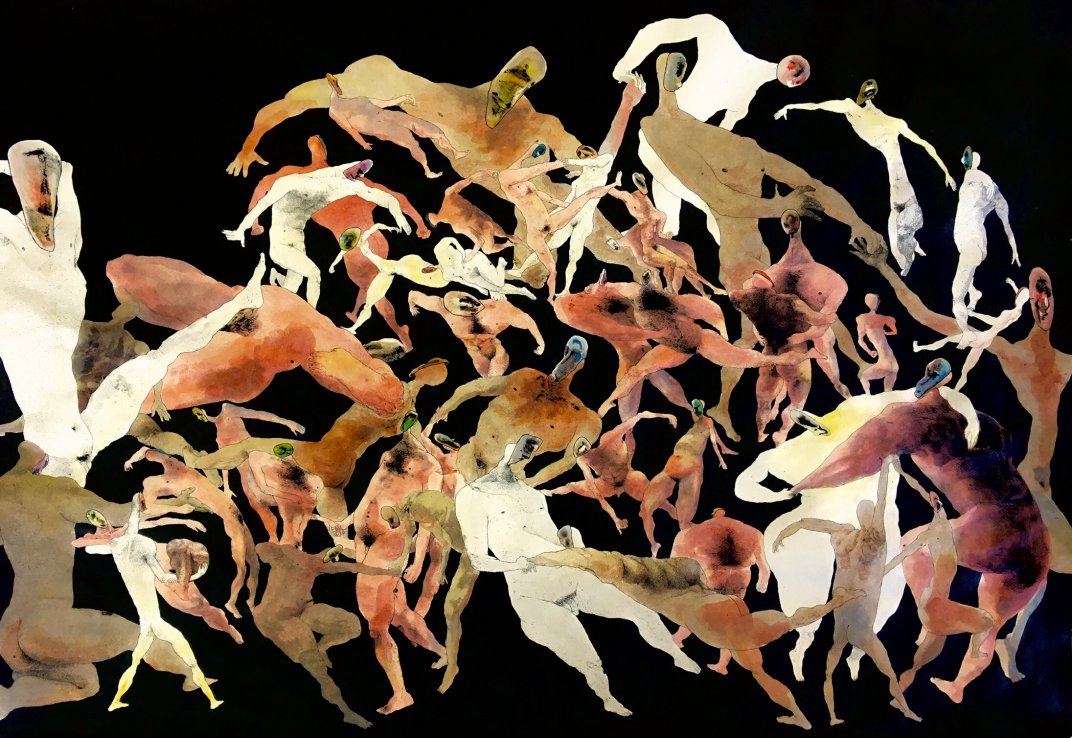
When I draw, I never have an intention, a predetermined shape in mind, at the very moment I start to draw on the paper, I don't know what I'm going to do yet. I access my imagination by following unexpected leads. To provoke them, I try to put all the clichés I have in my head aside and I let my hand draw autonomously, and I wait until, in the accumulation of lines, I see a place where some of them detach themselves and form a piece of face, hip, foot, whatever it is, and from which I untie the lines all around to recompose a body. And then I start over at a different place on the sheet. Thus by chance I explore the most extravagant morphologies, sometimes undulating and tenuous, sometimes adipose and puffy, but for which I am always careful not to obliterate the anthropomorphic physique.
When a semblance of composition begins to become clearer, I evaluate it more carefully, and look for in the posture of the bodies what could be the reflection of a narrative movement that would link them all, from that moment on I conceive of the composition as a theatrical space in which each new body is designed to interact with the rest of the troupe.
Through a single drawing, I want to evoke the trace of a story. A story of which only one scene remains, an enigmatic scene, which is never totally explicit about what is going on and what has been ellipsed. The aim is not so much to give a key to reading a presupposed narrative, but to enable everyone to envisage a story within the framework of the drawing, a story whose absence of title and text makes it easy to become the narrator oneself. It's a delayed story. It slips between all the bodies facing and observing each other. We can ignore it, consider the bodies for their graphic identity, or activate it whenever we want, as soon as we try to make some of them talk to each other.
For this drawing, I started by sketching lines randomly all over the sheet, as if I was applying a first mesh of scattered filaments. Once all the space has been pretty much twisted into lines, I'm going to untie a few bodies here and there in the knots.
Although I try to let myself be surprised by the figures I untangle, always looking for original postures and morphologies, their dimensions are nevertheless resolutely small, and under the weight of the format, they are as if crushed. So I have to have more of them bent until there are enough of them to deal consistently with the void in the sheet.
While composing my scene, I have in mind to follow the plot of a slightly burlesque and romantic dance.
From a graphic point of view, I want when you read the drawing from a distance, the whole composition is pulsating. Thus, within these bodies piled up jumbled together, I look for those whose postures can echo each other, merge into a single momentum, and I wanted to create through the treatment of colours and the reserves of white, like garlands of characters that wind from one edge to the other, intermingle, and tie the whole composition together to emanate a common synergy.
I hope that when we get closer, the composition untangles, that each character has a singular richness. I made sure that the work of inking and colour was more pronounced on some limbs than on others, in order to give a little more dynamism to their movement and weight to their bodies, and to leave in the most airy areas, like openings through which the gaze can sneak in to continue reading.
Finally, I chose the element of the mask, both to accentuate the theatrical attitude of the characters and to give the reader the possibility of seeing a narrative prism through which to imagine the figures in dialogue; but also to associate two contrasting graphic repertoires, whose unexpected combination enhances the aesthetics of the bodies.

